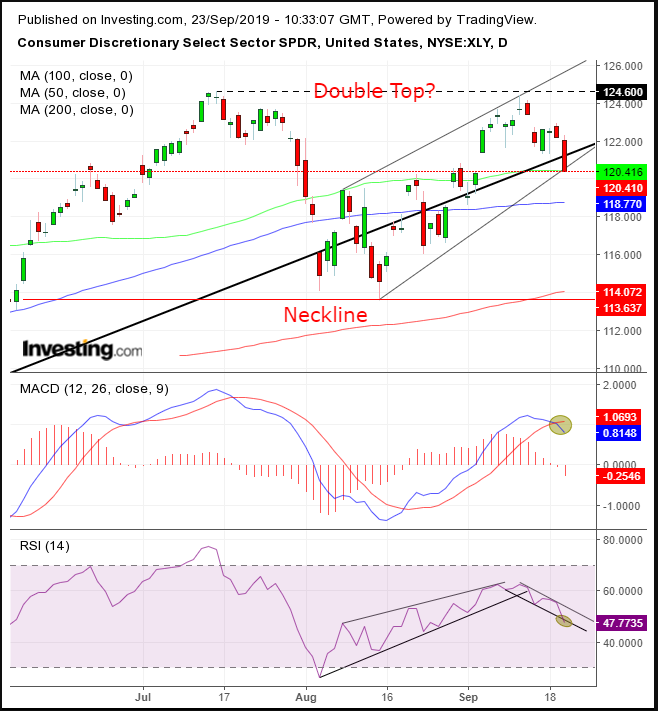U.S. futures are mixed today, despite reassurances that U.S.-China trade talks are on a solid path even after China's unexpected cancellation on Friday of a planned visit to U.S. farms.
This contradictory landscape has created a scenario in which stocks that were expected to bounce after Friday's shock news may instead fall even further.
The Consumer Discretionary sector ETF (NYSE:XLY) underperformed Friday, falling 1.47% below the uptrend line since the December bottom, increasing the chances of a reversal.
Maybe investors are not buying into Chinese assurances that it was actually a U.S. request that the planned visit to U.S. farms was postponed, and, by the way, that was discussed but never actually scheduled – which effectively contradicts the first excuse.
Or perhaps investors are starting to detach from hopes of an ever-elusive trade deal that may prove impossible to achieve before the U.S. Presidential elections.
While U.S. President Donald Trump may be at a bargaining disadvantage and ready to compromise, China's superior position is likely to strengthen their resolve, either by forcing Trump into submission — a capitulation he can’t afford before reelection — or by waiting out the potential loss of a contentious president. The Democrats would be all too happy to roll back tariffs with no demands on China.

On Friday, the Consumer Discretionary SPDR ETF (XLY) dropped below the uptrend line since the December bottom, as well as slightly below the bottom of a rising channel since the Aug. 15 bottom. The only other ETF to fall below the uptrend line since the December low is the Energy Select Sector SPDR (NYSE:XLE), which is in an established downtrend.
To clarify, the sub-index could still bounce above both uptrend lines, in the medium as well as the short term. So far, it has support of the 50 DMA, while the 200 DMA realigned with the Aug. 15 low, a potential double top neckline.
Having said that, an even lower close below the medium term uptrend line and short term rising channel would tip the scales further toward a reversal.
Both the MACD and the RSI have provided sell signals. The former’s short MA fell below the longer one, demonstrating recent weakness. The latter gave a heads up of falling out of the rising channel two weeks ago, and since then has developed a downtrend within a falling channel. Friday, it fell even lower than that, suggesting a steeper decline.
Trading Strategies
Conservative traders would wait for the medium term to settle on a clear trend, posting either a higher high or a lower low.
Moderate traders might enter a short after closing below the 200 DMA and proving resistance on a return move.
Aggressive traders may short at will, after matching a trade plan to their account.
Trade Sample
- Entry: $122
- Stop-Loss: $123, above Thursday’s high
- Target: $119, above 200 DMA
